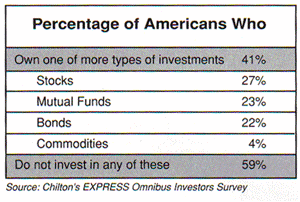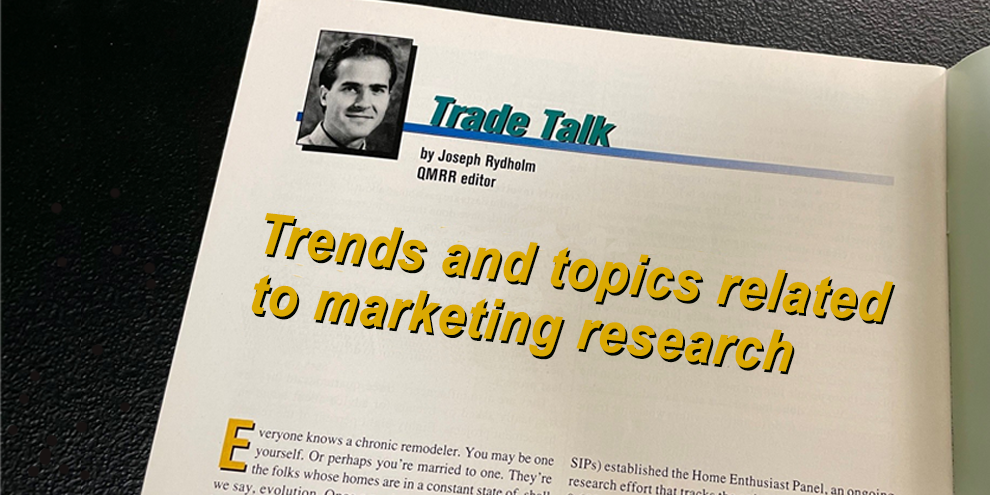I confess: I'm a mutual fund junkie. My house is littered with fund prospectuses (prospecti?). I fill my waking hours poring over The Wall Street Journal, Smart Money, Money and Kiplinger's and watching CNBC or "Wall Street Week."
Even if I don't have any cash to invest, I still think about mutual funds. Should I switch funds? Should I pick a different international fund? Are this fund's l2b-1 fees too high? At least I don't have photos of my favorite fund managers up on my walls - yet.
The worst thing is, I think I've drawn some of my friends and co-workers into my sickness. Pals who three years ago looked at me quizzically when I started blabbing about mutual funds now come up to me, with that telltale look in their eyes, and ask if I've heard anything about "that hot new sector fund."
At least we're not alone. There are millions of others with the investment bug. During the past few years, the assets of mutual funds have swelled to record levels as Jane and John Q. Public cashed in their CDs and savings accounts and jumped into the stock and bond market, hoping for double digit returns. Others have entered the market after realizing that social security and company pensions won't be enough to provide for retirement.
Things went smoothly in the market for a while before it tanked last year. Since then it's been a roller coaster. It seems like each week brings a new bugaboo: the Orange County mess, the earthquake in Kobe, the collapse of the peso, the specter of inflation and the fed's attendant interest rate shenanigans.
When will it end? Probably never. But I'm still in the market and I plan to be for the long term. According to surveys done by Chilton Research Services, Radnor, Pa., most other investors feel the same way.
Two separate phone surveys were conducted last fall of a nationwide random sample of adults 18 and older to determine the level of U.S. consumers' investment activity, to understand the demographics of investors, and to take the pulse of investors and non-investors regarding the current economic climate.
Optimism and resilience
The research found considerable optimism and resilience in investors' attitudes, says Bart Zehren, research consultant with the CRS Financial Services Group of Chilton Research Services. "They have a willingness to stay with the market for the long haul. People were realistic and ready to absorb what they expect to happen in terms of interest rates and inflation. Their expectations are moderate and realistic.
"Most of those investing have that long-term horizon, they're not speculators. They're not in because they think they're smarter than the market they're there because they have their savings tucked away in an IRA."
Zehren says he was impressed by the widespread nature of investing. "It's something that surely reaches into the middle class and isn't the domain of those in the highest income groups."
Some of the major findings:
- Two out of five (41 percent) Americans now invest in stocks, bonds, mutual funds or commodities;
- Two-thirds of those with incomes of $50,000 or more have some type of investment; half of them use a full service broker; one-quarter use a discount broker;
- Twenty-one percent of investors have all of their investments in a retirement account of some kind - an IRA, 401 (k) or Keogh account.
Age is, not surprisingly, the biggest influence on people's investing practices and outlook. For investing, the prime age range is 45-54. Up to age 45, investors are much more likely to say they expect to buy stocks than to sell them. After they hit 54, stock purchases drop sharply and selling is more common as investors turn towards concerns about stability and go to cash.

Those in the 55-64 age group were the least optimistic about the stock market. Only 19 percent expected stock prices to go up, compared to 31 percent of other age groups.
Regional differences
The research also uncovered some interesting regional differences in mutual fund investors. Those in the west are very concerned with a fund's financial objectives. Westerners and southerners said full disclosure of management fees, loads and other charges was very important. Midwesterners are more concerned about avoiding risk: they are the least likely to decrease their cash holdings (17 percent as compared to 27 percent to 29 percent in other regions). Midwesterners who are looking for mutual funds are more likely to place the highest importance on the fund's past performance.
Investors have higher average incomes than non-investors- $37,300 vs. $24,500 respectively. Investors are better-educated and are more likely to be white, married and work full-time.
As you might expect, investors were more bullish than non-investors. When the surveys were conducted, most investors felt the market would go up (either a little or a lot) or stay the same. While nearly half of investors expect to hold their current portfolios, 33 percent expected only to buy in the next six months, 16 percent expected to buy and sell. Only 4 percent expected only to sell.
Most investors and non-investors were realistic about another interest rate increase.
There were also some differences between the sexes. "Men's portfolios are less conservative, and they are more aggressive players than women overall. This pattern does not stem from differences in expectations about interest rates or inflation, but rather seems to reflect different concerns and priorities," Zehren says.
Three in ten men but only one in four women own stocks. Men take more risks and are for the most part more active in the market. Of mutual fund investors, 54 percent of the men and 41 percent of the women own shares in stock funds. 24 percent of the men and IS percent of the women are in corporate bond funds; 29 percent and 20 percent are in funds that invest in both. Women are more likely to invest in (ostensibly) more conservative vehicles like municipal, government or treasury bonds. Men more often invest in riskier, lowgrade corporate bonds.
Zehren says that despite these findings, marketers should be careful about rushing into marketing programs that play to one sex or the other. "The differences are at the margin. Both may be predominately of the same attitude, it's just that one is a stronger majority than the other, that's why I'd be cautious if I were them. One can find uninformed men and women, so I would use a mix of male and female portrayals [in advertising]."
Clear and up front
One opportunity the results present is for mutual funds to be clear and up front about their management fees and other expenses. Not only are investors interested in these numbers but they seem to seek out funds that make this information easy to find and understand.
For marketers of financial services, Zehren says the most important finding is that despite the market's gyrations, investors haven't been scared away.
"The research shows a receptive marketplace that wants to play ball and is quite realistic about the criteria they use to select their investments. They seemed to be reasonably informed and disciplined in the way that they operate."
